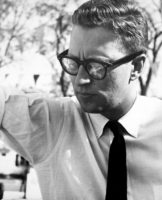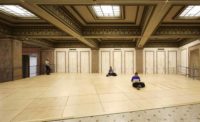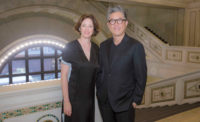Just as the most iconic building of the recent past, Frank Gehry’s Guggenheim Museum Bilbao, is turning 20 years old, the Chicago Architecture Biennial (CAB) offers some hints about who could design the next one. And it may well not be one of the usual suspects.
The Biennial, which opened September 16 and runs through January 7, is showcasing the work of more than 140 architects, designers, and allied artists from around the world, many of them relatively unknown in the U.S. While a few more senior figures—Toshiko Mori, Dominique Perrault, Kazuyo Sejima of SANAA—are included, most of the participants represent a new generation of talent, closer in age to CAB’s artistic directors—Sharon Johnston, 51, and Mark Lee, 49—or younger. The couple, founding partners of the nearly 20-year-old Los Angeles–based firm Johnston Marklee, are themselves having a banner year, not only with the Biennial but also the unveiling of their redesign of the Museum of Contemporary Art Chicago (page 51), and the imminent completion of the Menil Drawing Institute in Houston, their most important project to date.
Of course, for most architects who aren’t Bjarke Ingels, it takes at least 20 years of practice, if you’re lucky, to get a commission for a ground-up building for a prestigious cultural institution or similar high-profile project. So what can we expect from the younger architects on view in Chicago—those who are on the cusp of breaking through, and who presumably will be designing the next wave of museums, civic centers, theaters, performance halls, and maybe even significant typologies we can’t imagine yet? And what criteria link their work to the larger message of the Biennial?
The very title of the Biennial, Make New History (drawn from a work by artist Ed Ruscha), is a telling sign that the new generation—now comfortably distanced from Postmodernism and no longer enamored of the kind of radical parametric design we saw at the turn of this century—is not afraid to look to the past. “We’ve seen a renewal of interest in historical precedents among a generation of architects perhaps less encumbered by the past 30 years,” says Lee.
The projects on display in the Chicago Cultural Center—an 1897 Neoclassical former library building that manageably contains the bulk of the Biennial’s exhibitions—are, for the most part, conceptual rather than actual representations of built work. Though conjured in response to the broad theme of Make New History, they also allow the architects to express their own design impulses.
This is best witnessed in Vertical City, the highlight of the show. That exhibit brings together 16 firms to reconsider the 1922 design competition for the Chicago Tribune Tower, the most memorable entry for which was Adolf Loos’s design of a giant Doric column. Scale models from the 16 firms, each 16 feet high, alongside a model of Loos’s tower, create a sort of hypostyle hall on the Cultural Center’s top floor.
In fact, two of those firms—Barcelona-based Barozzi Veiga (record Vanguard 2014) and Basel-based Christ & Gantenbein, whose partners are each in their 40s—have, like the 43-year-old Ingels (who is not in the Biennial), already built significant museum projects—all in Switzerland. Barozzi Veiga, whose main interest is the specificity of different contexts, took inspiration from Chicago’s rich terra-cotta legacy and its later Miesian landmarks to create a black cuboid form that discreetly merges structure with surface ornament. The firm’s Graubünden Museum of Fine Arts in Chur, completed last year, similarly combines ornament within a rationalist structure. Emanuel Christ and Christoph Gantenbein, who completed two museums last year—an extension to the Swiss National Museum in Zurich and the Kunstmuseum Basel—draw from their longstanding research project on typologies with their students at the ETH in Zurich to introduce an objet trouvé into the mix. Their chosen model is an existing concrete garage tower in São Paulo built in 1964, which, to them, achieves a classical beauty based on its honest, and simple, structure.
On the other hand, many of the towers are whimsical. London-based Serie Architects looked to Asian pagodas for inspiration. The tiered tower Serie produced uses its multiple roofs “as opportunities, rather than limits,” according to founding partner Christopher Lee. Mexico City–based Tatiana Bilbao divided her lively tower into multiple sections, and brought in more than a dozen other studios as collaborators to design those individual areas, creating a patchwork vision that reflects the true diversity of a city.
The first Biennial, in 2015, attracted over half a million visitors. The second one will welcome at least that many, according to Mark Kelly, Chicago’s Department of Cultural Affairs and Special Events commissioner. Even if overly didactic, with long, sometimes arcane wall texts next to each of the displays, the exhibition is not just meant to remind us of the architecture that has come before us and to anticipate what’s next; it is also meant to entertain, inspire, and provoke.
One need not be an architect to enjoy the Biennial. For instance, Bijoy Jain of Studio Mumbai, in a section called “Civic Histories” that is devoted to the city and its representations, offers nearly 20-foot-high lyrical latticework sculptures made of thin bamboo sticks that are both awe-inspiring and ever so slight, suggesting that even the ephemeral can be monumental or vice versa. Jorge Otero-Pailos’s contribution, The Ethics of Dust, is a haunting work at the intersection of art, architecture, and preservation made of thin films of dust and pollution from historic buildings. Part of a section of the Biennial called Building Histories, Otero-Pailos presents several films taken from Westminster Hall, the birthplace of modern parliamentary democracy, and from the site of the 2011 white-supremacist terrorist attack on Norwegian ministries— among the few works on display that connect to the darker aspects of our world.
In a fourth and last section, Horizontal City—a counterpoint to Vertical City, where architects were asked to reconsider the architectural interior— Bureau Spectacular puts a witty twist on a house by Adolf Loos (who seems to have replaced Cedric Price as the dead architect du jour). The firm presents a model of Villa Müller (1930) as a viewing machine: to peer inside, to look out at the views from within, and to see blurred images of yourself on a reflective surface. Then the architects covered the little structure in fur. If the general public isn’t aware of Loos’s love of fur—what he referred to as the original textile—it doesn’t matter. The thing looks cool.
Sprinkled throughout the Cultural Center are extraordinary photographic works that engage with or are inspired by architecture. Some are highly abstract, like Philipp Schaerer’s sequence, Chicago Series. Photographer Filip Dujardin, with Chicago Shuffle, offers up collages of Chicago buildings of various types that feel surreal because they seem actually to have been built.
Many big-name architects working today, young or old, were noticeably excluded. And while some countries, like Belgium, are surprisingly well represented, others, like most of the Scandinavian ones, not at all. And, yes, the overwhelming majority of participants are men. This may be less an indicator of what’s to come for the profession than an indication of what guided Johnston and Lee, not least of which is how they imbued the Biennial with an element of discovery by choosing designers who are fairly new to the American scene. One obvious kinship among the participants, most of whom seem to take a carefully considered approach to architecture, is not just that they look at history—and many histories, at that—but they look at the details. Based purely on the strength of the Biennial, the future of architecture is bright.










Post a comment to this article
Report Abusive Comment